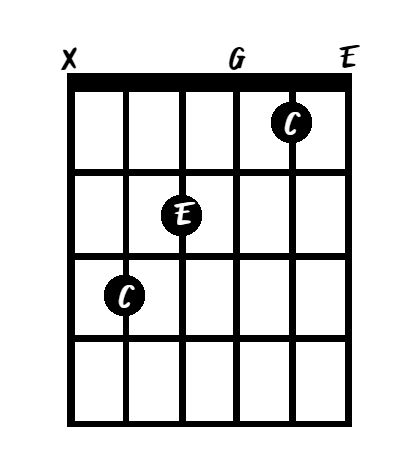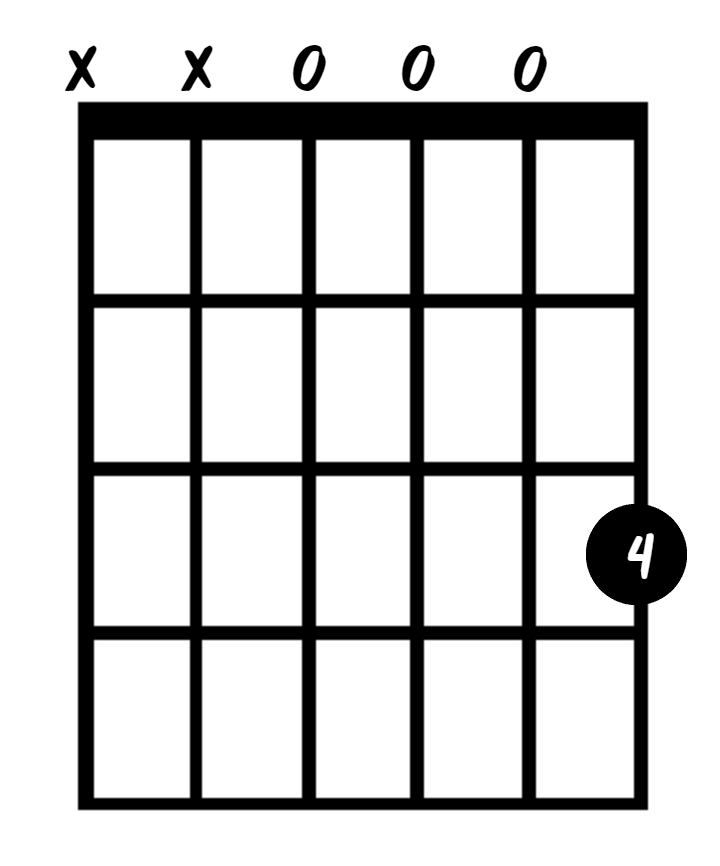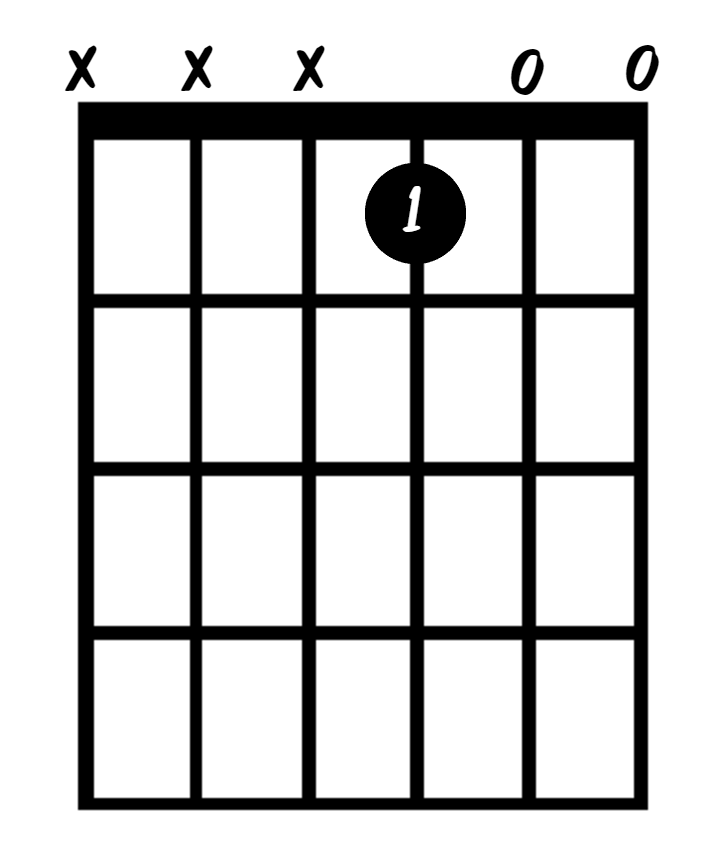
When you’re starting to learn how to play a chord on guitar, it’s easy to over complicate things. Guitar chords can seem mysterious and overwhelming at first. You’ll feel like the coordination required to switch from one chord to the next is something you’ll never develop.
And very often, guitar teachers don’t help matters much because they want you to jump right into full shapes that have become completely automatic for them. They lose site of how difficult it was for them to learn how to play a chord on guitar, and thus can no longer relate to how hard it is for you to learn how to play a chord on guitar.
That’s a true shame, because honestly, it just doesn’t have to be so difficult, even for very beginner guitarists. All you as a beginner need is a simplified approach. An approach that presents chords that you can master quickly to build a strong base and move on from with confidence.
A chord doesn’t need six strings
So, what is this simplified approach? Some things are just too basic to be broken down, right? I mean, if a song calls for an E chord, and you look up an E chord in a chart, then you have to play that shape you learn from the chart. Simple as that.
But it’s not. It’s even simpler if you know what really makes a chord a chord.
When you’re first learning how to play a chord on guitar, it’s natural to think that you have to play it just like the chart shows it. You need every string the chart tells you to play in order to play the chord.
But that’s not true. A chord does not need six strings. Or five, or even four! What does it need?
For a discussion on how the concept of using fewer strings plays into dynamics, see this article:
Whether advanced or basic guitar chords, you don’t have to play all the strings
What makes a chord a chord
Let’s talk about what you’re playing when you pick your guitar strings. If you pick just one string, then you’re playing a note, and it’s called just that: a note. If you pick two strings, then you’re playing two notes in unison.
Some call two notes played in unison an interval and some call it a dyad. Some might even call it a chord, but they’d probably be in for a lecture and an argument in most circles, so why bother?
It’s not until you get to playing three notes at the same time that most people will agree that you are truly playing a chord. You’ll hear it called a triad too, but that just means three notes played simultaneously, and most everyone is more comfortable with the name chord, so let’s go with common convention and talk about three (or more) notes played in unison as being a chord.
Start with easy chord forms and make faster progress
And that is the key to simplifying your learning process. Why try to force your fingers to do the crazy contortionist movements when you’re first learning how to play a chord on guitar? Why learn on chord forms that require five or six notes? Instead, why not just play chords that have only three notes each?
You’re still playing legitimate chords. True, they’re not the most sophisticated chords, but they’ll get the job done. Furthermore, they’ll give you confidence and make you a guitar player faster.
How you make a C chord on guitar

Let’s stick to a discussion of major chords here. One of the most common major chords on guitar is the C chord. The standard shape of an open C chord uses five of the six strings on your guitar.
But you don’t need all five of those strings to play a C chord on your guitar. Remember, you can make a chord with as few as three notes played in unison, so you only need three strings to legitimately play a C chord.
Well, how can a chord with just three notes be a C while a chord with five notes is also a C? Because although you’re playing five strings in the standard shape, two of those strings create the same notes as two other strings.
The location of the notes in a standard C chord

For instance, in the standard shape of an open C chord, both your third finger (which is on the A string at the third fret) and your first finger (which is on the B string at the first fret) create the note C. Those two C notes are an octave apart, so they sound a bit different, but they are both C notes nonetheless.
Similarly, your second finger plays fret two of the D string, which is an E note. The open High E string also sounds an E note an octave higher. So, in the standard open shape of a C chord, you have two Cs and two Es.
That means that you have one C note and one E note more than you really need. And that means you can eliminate one C and one E note and still have a complete C chord.
Every chord has a recipe
Now we know that a C chord contains a C note and an E note. The note G completes the C chord. In the common open chord shape for a C chord, the open G string provides the G note.
So, this is an important concept that we can explore later: every chord has a “recipe”. In other words, every chord has a specific combination of notes. In the case of a C chord, the notes are C, E, and G.
Here’s the important concept: Any time you play a C note simultaneously with an E note and a G note, you are playing a C chord. Always. No exceptions. Just those three notes make up a true and valid C chord. Knowing that, you now know how to play a chord on guitar.
You’ll learn later that you can add other notes to those three to create new and different chords, but if you play just those three notes, that’s a C chord. Always.
And they don’t have to be in any specific order. The C note can be higher or lower than the G note or the E note. Those three notes in any order make up a C chord every time.
And all of the other basic chords–both major and minor–can similarly be made up of a combination of just three notes.
You can play a simplified C chord for starters
So this fits in perfectly with the concept that I talk about in the you don’t have to play all the strings post.

You know from that article that no rule dictates that you must play all six strings. And now you can see just how valuable that concept is when it comes time to learn how to play a guitar chord. Because you now know that you can play as few as three strings and still have a real chord.
So, let’s go back to that C chord. We already discussed the fact that two of the notes that make up a C chord can be heard on strings in the open position. Specifically, the G string and the High E string.
Since you already have two notes of a C chord without even putting a finger on the fretboard, you only need one finger to push a string down in order to make a C note. To most easily accomplish that, push the B string down at the first fret with your first finger.
In other words, to play a true C chord on the guitar, simply push the B string at fret one with your pointer finger and then strum the three thinnest strings.
You can play a simplified G chord, too
Similarly, you can play the chords A, D, E, and G with just the top three strings and simplified shapes. Well, the G doesn’t conform quite so nicely because you need to add the D string too, but still it’s super easy. In fact, even easier than the others.

To play a G chord, you just need to play a G note, a B note, and a D note. And you can actually do that without pushing any strings down as long as you strum just the open D, G, and B strings. That might just be the easiest chord of all on the guitar!
Since that G chord is so easy, challenge yourself a bit and fret the High E string at the third fret with your pinky. That’s another G note. When you play this chord, strum all of the four thinnest strings. So now you have two one-finger versions of common chords, the C and the G.
Those two chords go together in thousands of different songs, and switching between these one-finger versions of them couldn’t be much easier.
One more chord completes the set
To play hundreds of songs, you only need one more chord, and that’s the D chord. There is a way to play a one-finger version of a D chord on the guitar, but it involves the three lowest strings. That wouldn’t sound great along with the other simple chords you’ve learned so far. So let’s take the plunge and learn the standard form of a D chord. You’ll need three fingers to do it, so this one’s a bit more complicated. But since the other two are so easy, it’ll be a good stretch for you!

Play the G string with the first finger at the second fret for an A note. Play the third fret of the B string with your third finger for a D note. Finally, play the second fret of the High E string with your second finger to sound an F#. Those three notes–D, A, and F# create a D chord.
Practice switching from each of these three chords to the other two. Do it over and over again until you can move easily between the three. When you can do that, you can play tons of songs.
And with the confidence that you build playing these easy shapes, you will be well poised to start adding in the other fingers that make up the full shapes.
You’ll get there. Just take it slow and start with these easy forms. Once you realize how easy it can be to learn how to play a chord on guitar, you’ll start making progress faster than ever.
Simplified E and A chords

There are also easy ways to play the E chord and the A chord.
For E, you have a one-finger shape. Use your first finger to play the first fret of the G string for a G# note. Play the open B and open high E strings for the notes B and E.
You can play an A chord with two fingers. Press the second fret of the G string with your first finger for an A note. Press the second fret of the B string with your third finger for a C# note. Add the open High E for an E note.

Now you have a whole set of simplified chords you can use
So now you can play simple three-string versions of the A, C, D, E, and G major chords. What about the B and the F? Well, those are a little more complicated, so let’s leave them for another lesson.
For now, just remember that it’s really not as hard to learn how to play a chord on guitar as you might have initially been lead to believe. Now that you realize it takes only three notes, these basic chords become even easier to master.
And once you’re comfortable, it’ll be easier to move on to the more complete chord forms that will eventually become second nature.
Simple three-note shapes are not just for beginners
Oh, and one more thing before we wrap this up. You may feel that this lesson is only about an easy approach to learning how to play a chord on guitar. And you might feel a little tinge of shame in having to resort to these simple three-note “baby” chords.
But nothing could be further from the truth. These simple three-note shapes are incredibly useful for many purposes, including lead guitar lines and passages. Lead guitar chord stabs cut through much more effectively when played with just three high notes as opposed to full five- or six-string versions.
Want to learn more about using simple chord shapes and how to use them?
Don’t underestimate these simple chords. You will use them just as often as–if not more often than–full shapes, depending upon the type of music you eventually come to play. They are extremely useful and important far beyond just learning how to play a chord on guitar!
Conclusion
It’s not as difficult to learn how to play a chord on guitar as you might think. And it’s not as difficult as some guitar teachers make it.
Once you learn what makes a chord, you learn that you can make many simplified chords with just one or two fingers.
You can master these simple shapes to find quick success and confidence. But don’t sell them short. Lead guitarists use they simple shapes all the time as powerful accenting tools.
